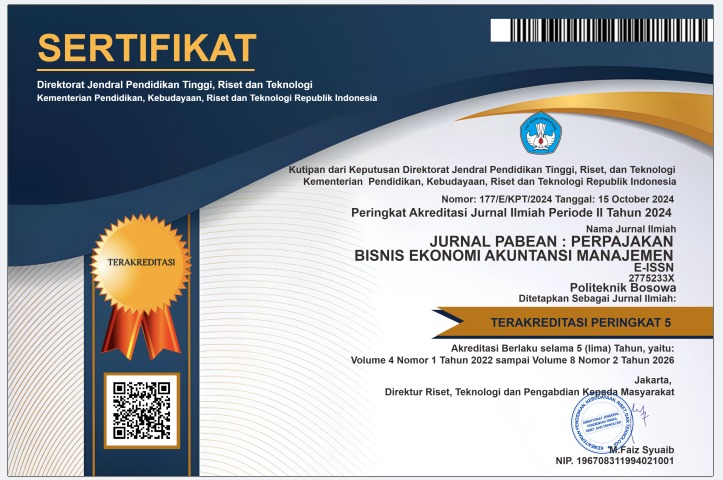DAYA TARIK BANK SYARIAH DITILIK DARI ISLAMICITY PERFORMANCE INDEKS DAN DUKUNGAN REGULASI
DOI:
https://doi.org/10.61141/pabean.v7i2.727Keywords:
Islamicity performance index, Islamic banks, POJK, Attraction, mix methodAbstract
Since the beginning of the operation of Islamic banks in Indonesia in the 1990s, there has been significant progress in the Indonesian banking world. Islamic banks are growing rapidly day by day. The development is evident from the increasing number of Islamic banks. With various developments that have occurred, the number of Islamic bank customers in Indonesia is lower than the number of conventional bank customers. This study aims to conduct further studies in order to determine strategies to increase the attractiveness of Islamic banks. The Islamicity performance index is a measuring tool commonly used to determine the level of progress of Islamic banks, in this study the Islamicity performance index will be used as a basis for determining the contributing factors to the attractiveness of Islamic banks. This study will also examine the factors that increase the attractiveness of Islamic banks based on regulatory support. This study uses a mix method to study the supporting factors of the attractiveness of Islamic banks. The quantitative method is applied to the use of the Islamicity performance index while the qualitative method is used to explore the supporting factors of the attractiveness of Islamic banks in terms of regulatory support. The Islamicity performance index is calculated by calculating the ratio while the normative legal approach will be carried out in the analysis of regulatory support. The research sample is a sharia general bank that received the best performance predicate in the sharia bank category in 2024. The sharia bank is the result of the merger of 3 sharia general banks in January 2021. The results of the study found that based on the results of the IPI calculation and POJK analysis, sharia banks can increase their attractiveness in terms of social aspects, aspects of product and service conformity with sharia principles and aspects of security for customers and prospective customers.References
https://www.ums.ac.id/berita/penelitian/merespon-fluktuasi-suku-bunga-nasabah-bank-syariah-tetap-loyal-secara-agama
Ahyar A. Gayo. (2011). Hukum Tentang Kedudukan Fatwa Mui Dalam Upaya Mendorong Pelaksanaan Ekonomi Syariah.
Aliyah, A. R. (2023). Peran Fatwa DSN MUI Terhadap Operasional Dan Aktivitas Bisnis Pada Lembaga Keuangan Syari’ah (LKS)). Irsyaduna: Jurnal Studi Kemahasiswaaan, 3(2), 189–204. https://doi.org/10.54437/irsyaduna.v3i2.1035
Amrillah, M. U. (2020). Urgensi Pembentukan Undang-Undang Digital Banking Bagi Perbankan Syariah Di Indonesia. Jurnal Lex Renaissance, 5(4), 928–945. https://doi.org/10.20885/jlr.vol5.iss4.art12
Andraeny, D., & Putri, D. D. (2017). Islamicity Financial Performance Index in Indonesian Islamic Banks. Shirkah: Journal of Economics and Business, 2(3). https://doi.org/10.22515/shirkah.v2i3.170
Baydoun, N., Sulaiman, M., Ibrahim, S., & Willet, R. (2018). Principles of Islamic Accounting. John Wiley & Sons Singapore Pte. Ltd. https://id1lib.org/
Dewi, L. (2024). Development of an Index for Measuring Islamic Bank CSR Disclosures in Indonesia. El-Jizya : Jurnal Ekonomi Islam, 12(1), 53–68. https://doi.org/10.24090/ej.v12i1.8196
Dewi, N. I., & Rofiuddin, M. (2023). Mengukur Kinerja Keuangan Perbankan Syariah pada Masa Pandemi Pasca Turun SK/Edaran POJK No.18/POJK.03/2020. Journal of Accounting and Digital Finance, 3(2), 94–106. https://doi.org/10.53088/jadfi.v3i2.368
Fahrurrodzi, M. F. (2018). Akad pembiayaan murabahah dan musyarakah pada perbankan syariah menurut Kompilasi Hukum Ekonomi Syariah (KHES) DAN PERATURAN Otoritas Jasa Keuangan (POJK) kesesuaian dengan Fatwa Dewan Syariah Nasional Majelis Ulama Indonesia [Universitas Islam Negeri Syarif Hidayatullah Jakarta]. https://repository.uinjkt.ac.id/dspace/handle/123456789/43037%0Ahttps://repository.uinjkt.ac.id/dspace/bitstream/123456789/43037/1/MUHAMMAD FAHMI FAHRURRODZI-FSH.pdf
Faizi, & Satrio Adiputro. (2023). Restrukturisasi Pembiayaan Bermasalah pada Perbankan Syariah di Masa Pandemi Covid-19: Perspektif Fatwa MUI dan POJK. IQTISHADIA Jurnal Ekonomi & Perbankan Syariah, 10(1), 49–66. https://doi.org/10.19105/iqtishadia.v10i1.8069
Farag, H., Mallin, C., & Ow-yong, K. (2014). Corporate Social Responsibility and Financial Perfomance in Islamic Banks. Journal of Economic Behavior and Organization, 103(Supplement), S21–S38. https://doi.org/10.1016/j.jebo.2014.03.001
Fatmawatie, N. (2021). Implementation of The Islamicity Performance Index Approach to Analysis of Sharia Banking Financial Performance In Indonesia. Iqtishoduna, 17(1), 17–30. https://doi.org/10.18860/iq.v17i1.10645
Felani, H., Wahyuni, S., & Pratama, B. C. (2020). The Analysis Effect of Islamicity Performance Index on the Financial Performance of Sharia Commercial Banks in Indonesia. Journal of Economics Research and Social Sciences, 4(2), 129–139. https://doi.org/10.18196/jerss.v4i2.8389
Fitriani, A. P., Sutrisno, & Rahman, A. F. (2018). Analyzing Factors that Influence Syariah Commercial Bank Financial Performance in Indonesia Based on Syariah Enterprise Theory (SET) Perspective. Jurnal Akuntansi, 22(2), 192–209. https://doi.org/10.24912/ja.v22i2.347
Hakim Nasution, F., Syahran Jailani, M., & Junaidi, R. (2024). Kombinasi (Mixed-Methods) dalam Praktis Penelitian Ilmiah. Journal Genta Mulia, 15(2), 251–256. https://ejournal.stkipbbm.ac.id/index.php/gm
Hassan, A., & Harahap, S. S. (2010). Exploring Corporate Social Responsibility Disclosure: The Case of Islamic Banks. International Journal of Islamic and Middle Eastern Finance and Management, 3(3), 203–227. https://doi.org/10.1108/17538391011072417
Heriyanto, M. (2024). BSI Raih Predikat Bank Syariah Pendukung Pengendalian Moneter Terbaik. Antara. https://www.antaranews.com/berita/4508397/bsi-raih-predikat-bank-syariah-pendukung-pengendalian-moneter-terbaik
Husni Shabri. (2022). Transformasi Digital Industri Perbankan Syariah Indonesia. El-Kahfi | Journal of Islamic Economics, 3(02), 1–7. https://doi.org/10.58958/elkahfi.v3i02.88
Kasih, A. M. (2017). Faktor-Faktor yang Mempengaruhi Pengungkapan Islamic Social Reporting. http://repository.uinjkt.ac.id/dspace/bitstream/123456789/35451
Latifah, E. (2020). Sharia’ah Enterprise Theory (Amanah) Pada Pendekatan Behavioral Accounting dalam Menilai Shariah Microfinance (Studi Kasus Pada Koperasi Syariah Lamongan). Jurnal Shidqia Nusantara, 1(1), 61–75.
Mardianto, M. F. F., Cahyono, E. F., Previan, A. T., Fitrianingsih, E. R., & Fauzan, M. H. (2023). Determinant of Customer Loyalty for Bank Syariah Indonesia After M&a Activity Based on Confirmatory Factor Analysis. Jurnal Ekonomi Dan Bisnis Islam (Journal of Islamic Economics and Business), 9(2), 429–462. https://doi.org/10.20473/jebis.v9i2.48051
Muhammad, W. I. (2019). Keberanjakan Fatwa dari Legal Opinion menjadi Legal Binding: (Studi Kasus Fatwa DSN MUI Tentang Perbankan Syariah). Jurisprudensi: Jurnal Ilmu Syariah, Perundang-Undangan, Ekonomi Islam, 11(2), 146–163. https://doi.org/10.32505/jurisprudensi.v11i2.996
Mutia, E., Jannah, R., & Rahmawaty. (2018). Islamicity Performance Index of Islamic Banking in Indonesia. Advances in Social Science, Edication and Humanities Research, 292(Agc), 424–436.
Nugraha, J. A. (2020). Lingkaran Setan Kemiskinan di Kota Tasikmalaya dan Gagasan Manajemen Zakat Produktif sebagai Solusi. LA ZHULMA: Jurnal Ekonomi Syariah, 1(1), 61–98.
Othman, R., Thani, A. M., & Ghani, E. K. (2009). Determinants of Islamic Social Reporting Among Top Shariah -Approved Companies in Bursa Malaysia. Research Journal of International Studies, 12(12), 4–20.
Pane, I., Hadju, V. A., Maghfuroh, L., Akbar, H., Simamora, R. S., Lestari, Z. W., Galih, A. P., Wijayanto, P. W., Waluyo, Uslan, & Aulia, U. (2021). Desain Penelitian Mixed Method Desain Penelitian Mixed Method. In N. Saputra (Ed.), Yayasan Penerbit Muhammad Zaini (Issue November). Yayasan Penerbit Muhammad Zaini.
Peraturan Otoritas Jasa Keuangan Nomor 21/POJK.03/2014 Tentang Kewajiban Penyediaan Modal Minimum Bank Umum Syariah, Pub. L. No. 21/POJK.03/2014 (2014).
Peraturan Otoritas Jasa Keuangan Nomor 24 /POJK.03/2015 Tentang Produk Dan Aktivitas Bank Syariah Dan Unit Usaha Syariah, Pub. L. No. 24 /POJK.03/2015 (2015).
Peraturan Otoritas Jasa Keuangan Nomor 31/POJK.05/2014 Tentang Penyelenggaraan Usaha Pembiayaan Syariah, Pub. L. No. 31/POJK.05/2014, Ojk.Go.Id (2014). http://www.ojk.go.id
Peraturan Otoritas Jasa Keuangan Nomor 8/POJK.03/2014 Tentang Penilaian Tingkat Kesehatan Bank Umum Syariah Dan Unit Usaha Syariah, Pub. L. No. 8/POJK.03/2014, Ojk.Go.Id 1 (2014).
Pujiati. (2024). Metode Penelitian Kombinasi: Karakteristik, Jenis, Langkah. Deepublish. http://scioteca.caf.com/bitstream/handle/123456789/1091/RED2017-Eng-8ene.pdf?sequence=12&isAllowed=y%0Ahttp://dx.doi.org/10.1016/j.regsciurbeco.2008.06.005%0Ahttps://www.researchgate.net/publication/305320484_SISTEM_PEMBETUNGAN_TERPUSAT_STRATEGI_MELESTARI
Purnomo, S. D., Cahyo, H., & Mukharomah, S. A. (2021). Analisis Faktor-Faktor yang Mempengaruhi Minat Menabung di Bank Syariah pada Masyarakat Kabupaten Banyumas. J-MAS (Jurnal Manajemen Dan Sains), 6(2), 343. https://doi.org/10.33087/jmas.v6i2.273
Rahmatika, C. I., Yustati, H., Syariah, S. E., Islam, U., Fatmawati, N., & Bengkulu, S. (2024). Analisis Pengaruh Fatwa MUI terhadap Perkembangan Ekonomi Syariah di Indonesia. Jurnal Penelitian Ilmu Ekonomi Dan Keuangan Syariah, 2(4), 79–90.
Sari, N. E. (2023). Bank Konvensional lebih Banyak Digunakan di Indonesia Dibandingkan Bank Syariah. Kompasiana. http://scioteca.caf.com/bitstream/handle/123456789/1091/RED2017-Eng-8ene.pdf?sequence=12&isAllowed=y%0Ahttp://dx.doi.org/10.1016/j.regsciurbeco.2008.06.005%0Ahttps://www.researchgate.net/publication/305320484_SISTEM_PEMBETUNGAN_TERPUSAT_STRATEGI_MELESTARI
Setiawan, I., Huda, M., Islamia, H. N., & Aulia, R. (2023). Implementasi Fatwa DSN MUI No.04/DSN-MUI/2000 Tentang Murabahah Pada LKS: Sebuah Studi Literatur. Journal of Fiqh in Contemporary Financial Transactions, 1(1), 1–14. https://doi.org/10.61111/jfcft.v1i1.440
Sormin, S. K., Ardiansyah, M. V., & Darda, M. bin. (2023). Kurangnya Nasabah Di Bank Syariah Dibandingkan Bank Konvensional. Karimah Tauhid, 2(4), 1080–1086.
Syara Sabilla Fauziani, Lala Nardilah Nur Azmi, & Dewi Anggarani. (2023). Strategy for the Distribution of Zakat, Infaq and Sedekah Funds in An Effort to Increasing Public Awwareness (Case Study BAZNAS Tasikmalaya Regency). Journal of Islamic Economic Scholar, 4(2), 53–61. https://doi.org/10.14421/jies.2023.4.2.53-61











